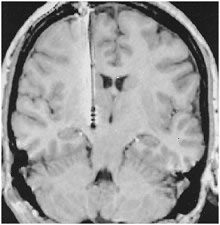What's Deep Brain Stimulation (DBS)?
DBS involves surgical implantation of a medical device that sends electrical stimulated impulses to specific areas of the brain [2]. A medical device called a neurostimulator is similar to a heart pacemaker. And, its size is about a stopwatch. The DBS system consists of three components: the lead, the extension, and the neurostimulator. The lead is a thin insulated wire with an exposed tip positioned in target area of the brain [1]. The extension is also an insulated wire which connects the lead to the neurostimulator. It is passed usually under the skin of the head, neck, and shoulder [1]. And, the neurostimulator is generally placed under the skin near the collarbone. Or, it can be implanted lower in the chest or in the abdomen in some cases [1]. Electrical impulses are generated in the neurostimulator and sent to the lead via the extension. In treatment of the Parkinson's disease (PD), these impulses interfere with and block the electrical signals that cause PD symptoms [1]. The target area is obtained through noninvasive high-resolution images such magnetic resonance imaging (MRI) and computed tomography (CT)
with stereotactic frames.




